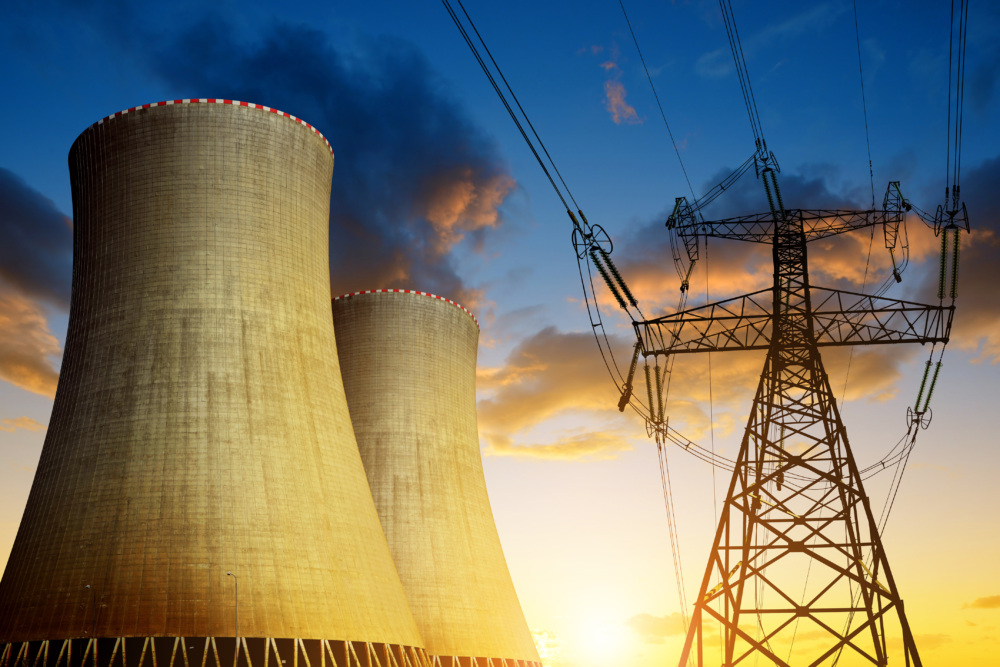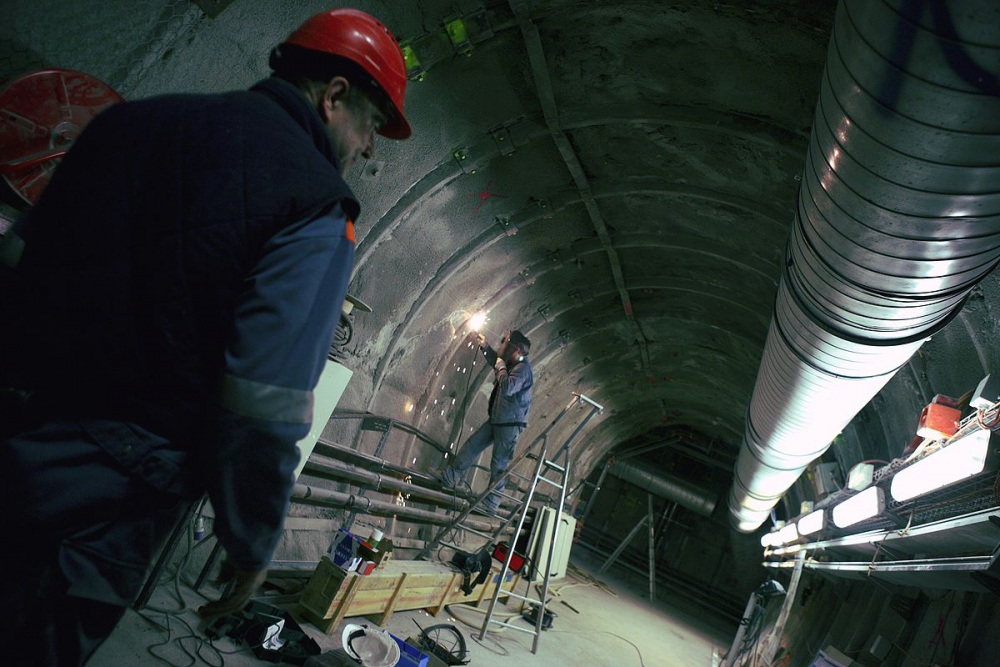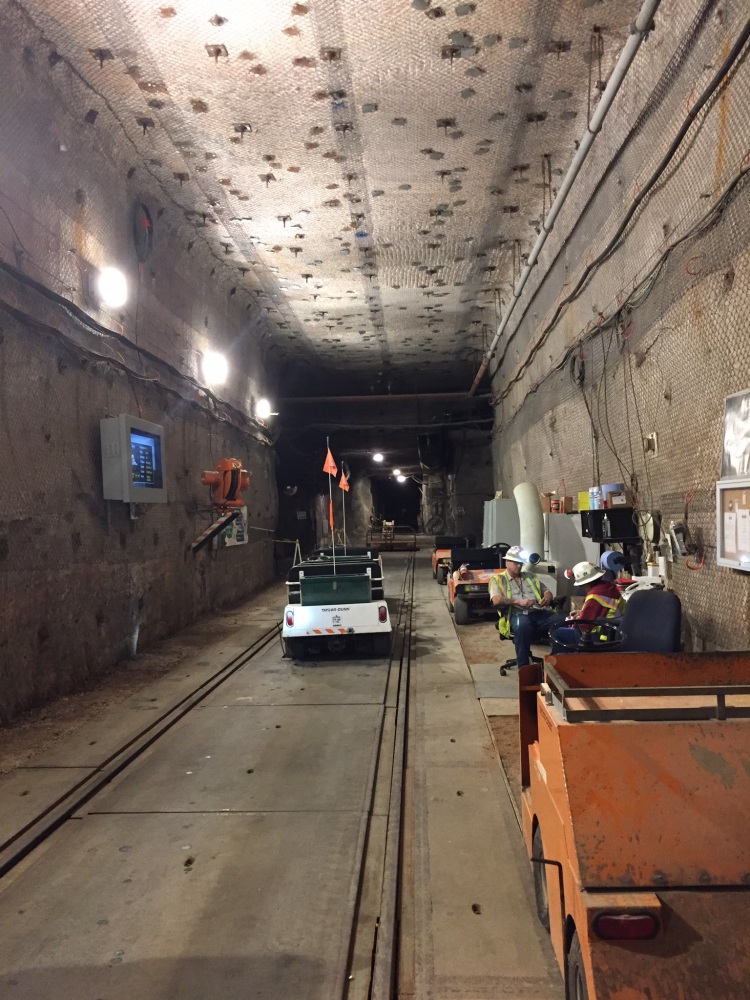
Andrew Newman PhD
Senior Director for Nuclear Fuel Cycle Activities
Atomic Pulse
About the image
Atoms, the basic building blocks of life, crave stability. Most atoms are stable but some are not, due to an excess of protons or neutrons. These unstable atoms, or radionuclides, undergo spontaneous transformations—also known as “disintegrations”—in their quest for stability. This process of radioactive decay involves the release of energy or radiation.
Because of its radioactivity, material that is no longer being used for its intended purpose such as powering a nuclear reactor – i.e. waste – must be stored and disposed of in ways that provide adequate protection to the public for extended periods. For spent fuel and high-level waste (HLW), this timeframe is substantial. While most fission products decay in months-to-decades, some remain radioactive for much longer. These include iodine-129 which has a half-life of 15.7 million years.
Reaching agreement on what to do with this left-over nuclear material has eluded many scientists and engineers, politicians and publics for decades.
No country has yet operationalized a permanent spent fuel/HLW-disposal solution, though Finland is on the verge of becoming the first. But plenty of possible solutions have been proffered over the years … some better than others.[1]
Going Underground
Disposal in a deep geological repository is the internationally accepted best practice for permanently isolating spent nuclear fuel and high-level waste. Repositories are anticipated to be situated up to half a mile (between 300 and 800 meters) below ground and to be comprised of mined tunnels and/or caverns into which packaged waste would be placed and then surrounded by buffer and backfill material like clay or cement.[2] Finland is now constructing a repository 1,410 feet (430 meters) deep in the high-grade metamorphic bedrock of Olkiluoto Island that is expected to begin receiving spent fuel by the mid-2020s, which will make it the first operating repository for commercial spent fuel in the world.
The United States already operates the Waste Isolation Pilot Plant 2,150 feet (665 meters) deep in Permian salt beds near Carlsbad, New Mexico, but this is only for certain long-lived wastes from defense-generated nuclear activities. To manage the rest, from both defense programs and the commercial nuclear industry, a vast amount of repository technical research and development work has been conducted over many decades but finding willing host communities to take the waste has been a major challenge.

Another approach, borehole disposal, also has been investigated since the 1950s. Boreholes are designed to bury waste in narrow vertical or deviated shafts. The exact depth and diameter is site- and waste-specific but current drilling technology suggests that 5 kilometers (3 miles) deep and 17 inches (43 centimeters) in diameter to accommodate the widest waste packages (such as spent fuel) is feasible. Experts have determined that super deep (6 to 12 miles or 10-20 kilometers) disposal is not viable for a variety of technical and economic reasons.
Hydrofracture (fracking) also has been considered, and from 1964 to 1979 Oak Ridge National Laboratory used the technique to inject an intermediate-level waste and grout mixture 700 to 1,000 feet (210 to 300 meters) under lab property in the Conasauga shale formation that extends through Tennessee, Alabama, and Georgia.[3] But this approach has not been adopted more widely because of uncertainty around the integrity of long-term containment. Put more plainly, experts were not sure the waste would stay where they put it.[4]

Scientific consideration also has been given to the concept of “rock melt” – the insertion of high-level waste or dissolved spent fuel in solution or slurry form into deep underground cavities. The idea is that the cavities boil dry and the heat from the decay dissolves the waste in the surrounding molten rock. Eventually the mixture would cool and solidify in a process estimated to take about a thousand years. Among other drawbacks, the waste would be mobile during the solidification phase. This is one of several reasons why this and other liquid waste alternatives such as well injection – deep (½-3 miles or 1-5 kilometers) into porous strata or shallow (1,000-1,650 feet or 300-500 meters) into fracked shale – have been rejected in favor of solid waste disposal.[5]
A Watery Grave
The idea of dumping radioactive waste into oceans goes back to the beginning of the nuclear age, and at least 13 countries have declared that they dumped mainly low-level waste at various times between the 1950s and the early 1980s into the ocean as well as seas, bays, coastal waters, rivers, lakes, and even sewage systems. For almost all, this practice became a relic of the past in 1983 when the parties to the London Dumping Convention agreed to a moratorium on such activities. However, in 1993 Japanese television networks filmed a Russian navy tanker dumping low-level radioactive waste into the Sea of Japan mere days after President Yeltsin, during a visit to Tokyo, had assured Prime Minister Hosokawa that such practices would stop.[6] Despite all of this, a significant amount of research has been dedicated to returning to ocean disposal—but not through dumping in the water, rather by burying waste far below the water.
Sub-seabed disposal was the brainchild of the late Dr. Charley Hollister of the Woods Hole Oceanographic Institution in Massachusetts in 1973. By the 1980s, the concept had evolved into three main variants: sea trenches 7-10 kilometers or 4⅓-6¼ miles deep; stable sea floors (abyssal plains) 4-6 kilometers or 2½-3¾ miles deep; and areas with relatively high sedimentation rates 2-4 kilometers or 1¼-2½ miles deep.
Sub-seabed disposal research was institutionalized internationally and in the United States. A Seabed Working Group was created in 1977 under the auspices of the Organization for Economic Co-operation and Development’s Nuclear Energy Agency to provide “scientific and technical information to enable international and national authorities to assess the long-term safety and engineering feasibility of seabed disposal.” In 1987, U.S. Nuclear Waste Policy Amendments Act created an Office of Sub-seabed Disposal Research within the Department of Energy.[7] Particular attention was paid to two emplacement options: waste canisters lowered into pre-drilled holes in the basement rock and closed with cement and steel or titanium waste canisters in missile-shaped penetrators dropped from a ship to bury themselves at least 20 meters or 65 feet (deeper if “boosted”) into the seabed sediment which would chemically bind with some but not all of the radionuclides.[8] In addition to the expense of such an undertaking, impediments to these approaches include the uncertainty around amending the relevant international treaties, the risk of transport accidents, and unanswered technical and environmental questions related to the sediment, the canister, and the waste form.[9]

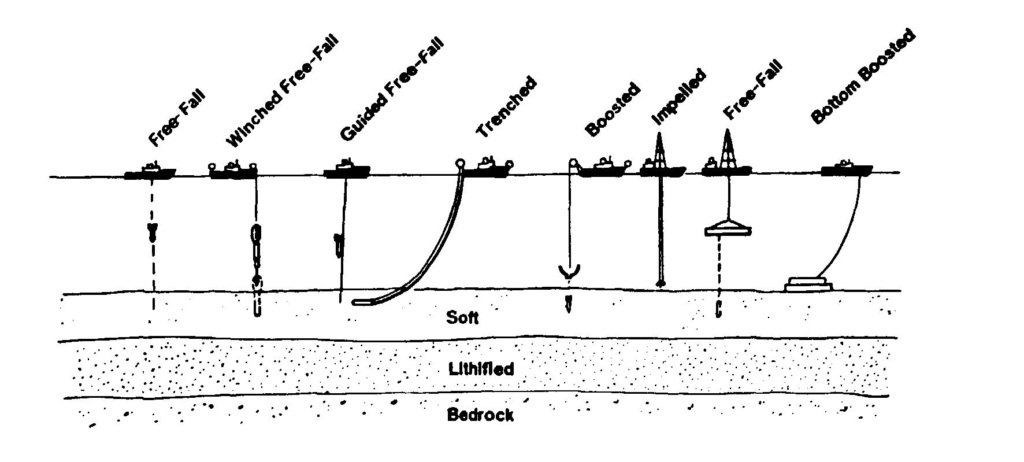
Still, research around and promotion of these ideas continues. In 2016, the concept was pitched at the Waste Management Conference in Phoenix.[10]
More radical ideas also have been proffered. In January 2008, Slate Magazine answered its reader-selected question of 2007: “Why don’t we drop medical waste and nuclear waste into active volcanoes?” The two most obvious reasons are containment (eruptions eject material outward into the atmosphere) and temperature (the lava is not hot enough to incinerate nuclear waste). Those concerns hadn’t swayed former artillery officer Larry Altersitz. Five years earlier, he had already devised a work-around and filed a patent for a cylindrical container with a sharp nose, tapered body, and capped rear end—something like a large artillery shell. Made from such materials as steel, concrete, heat-resistant plastic, porcelain, lead, and even slightly modified empty nuclear reactors, the containers could be filled with nuclear waste and dropped into the sea where they would penetrate the seabed in the path of an undersea volcano pouring lava.[11] Altersitz even had an active volcano in mind: Lō‘ihi Seamount, about 18½ miles (30 kilometers) south of the Island of Hawai’i.
Despite a more compelling technical case and Altersitz’s invention, submarine volcanoes have not proven any more acceptable than their terrestrial counterparts.
But the creativity does not stop there. Fully embracing the “go big or go home” ethos, former physics student and one-time San Diego singer/songwriter Rainer Schottlaender emailed the Blue Ribbon Commission on America’s Nuclear Future in May 2011 that disposing of the nation’s nuclear waste hundreds of kilometers deep in the earth’s magma was not only feasible but safe for millions of years.[12]
Small, uninhabited or purpose-built artificial islands also have been studied as disposal locations. Waste-handling shafts would start at the surface and the disposal tunnels would extend below the ocean.[13] In the 1990s, Bikini Atoll, Palmyra Atoll, and Wake Island in the Pacific Ocean all were proposed as hosts for nuclear waste storage and/or disposal—and rejected by surrounding island nations.
Yet another idea: a geological repository constructed offshore in national waters and accessed from land via ramps on the mainland.[14] The Swedish Nuclear Fuel and Waste Management Organization already operates such a facility for short-lived low and intermediate level radioactive waste 50 meters (164 feet) below the bottom of the Baltic Sea next to the Forsmark nuclear plant.[15] University of Sheffield Nuclear Materials Chemistry Professor Neil Hyatt recently suggested this approach for Britain’s intermediate and high level waste.[16]
Trapped Under Ice
What about using the world’s massive ice sheets?
First proposed in 1956,[17] by the 1980s ice-sheet disposal in Antarctica or Greenland consisted of two variants:
Quite apart from sociopolitical and legal challenges (disposal in Antarctica is banned by international treaty and disposal in Greenland would require local government and Danish parliamentary approval), the main disadvantages are high transportation and operational costs, uncertain ice dynamics, and the possibility of adverse global climatic effects.[18]

The Final Frontier
The U.S. National Aeronautics and Space Administration’s first comprehensive space disposal studies began in the early 1970s and focused on a nuclear waste payload launched into low Earth orbit by space shuttle then delivered to solar orbit or the lunar surface by an Orbit Transfer Vehicle (“space tug”). Scientists studied systems to send fully shielded payloads of various sizes to destinations that included orbits around the sun, moon, and Earth and the surfaces of the eight planets (excluding Earth and before Pluto was reclassified as a dwarf planet). Asteroids, and the moon were included, as well as a particularly demanding solar impact option.[19]
One of the presumed main benefits of space disposal was permanence – once the waste was out of the Earth’s atmosphere, it was gone forever – but even this was not certain for orbital variants. For example, orbits “around earth or around the sun in the inner solar system change over time periods that are short compared to the lifetime of waste components, so that a waste package placed in such orbits conceivably could return to earth.”[20]
While technically feasible – of the options, an orbit around the sun between the Earth and Venus was considered the lowest risk – operational requirements were staggering and numerous uncertainties remained. Among them: cost (particularly for operations, the launch vehicle, and potential rescue operations), payload mass and size (making high-volume wastes such as spent fuel prohibitively expensive), technology development (including ceramic-metal waste forms and containment), and the risk of launch pad accidents and low earth orbit failures.[21] The 1986 Challenger disaster tragically demonstrated the risks of space launch and effectively ended research into this concept.
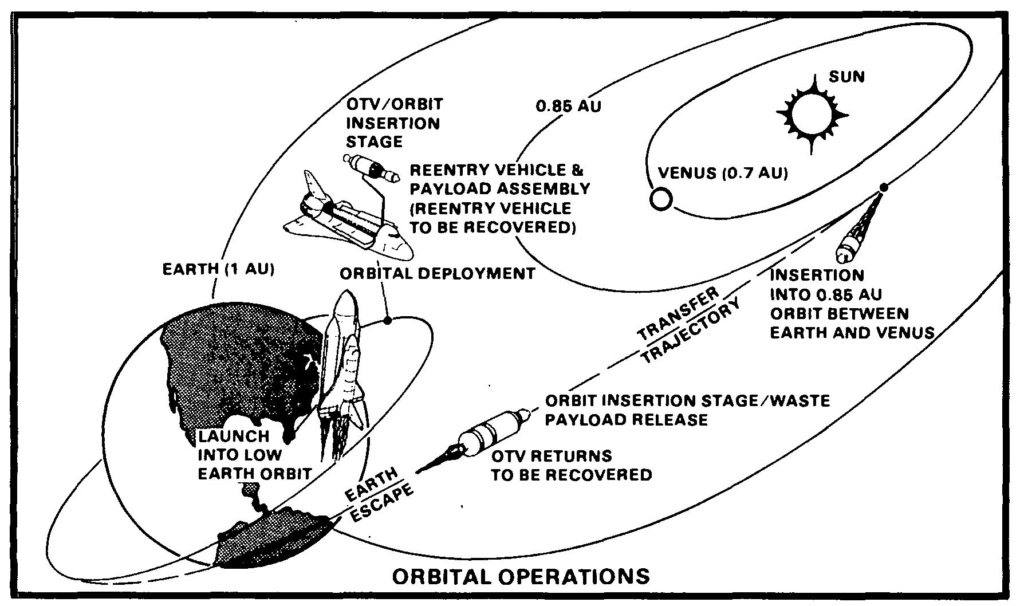
An “Atomic Death Belt”
Thirteen years after President Truman relieved him as Commander-in-Chief of the United Nations Command of the Korean War, General Douglas MacArthur claimed in his memoir: “If I were still not permitted to attack the massed enemy reinforcements across the Yalu, or destroy its bridges, I would sever Korea from Manchuria by laying a field of radioactive wastes—the byproducts of atomic manufacture—across all the major lines of enemy supply.”[22]
Contemporaneously during the same conflict, Congressman Albert Gore, Sr. (D-TN) sent a letter to Truman proposing that the United States spread a strip of radioactive waste across the Korean peninsula to prevent further counterattacks by Chinese and North Korean communist forces. This “atomic death belt” would require periodic re-contamination and radio broadcasts would warn the enemy that entering the zone “would mean certain death or slow deformity to all foot soldiers.” Gore saw not only military utility but also fiscal responsibility in the plan: using waste generated by the production of plutonium that would otherwise have to be “buried [in the U.S.] at great expense to safeguard inhabited areas.”[23]
But that was a very different time—the early days of the Cold War with the US involved in a shooting war to stop the march of communism across the globe. No one would suggest something like that today, right? Wrong! In response to U.S. Customs and Border Protection’s March 2017 request for proposals to design and construct a U.S.-Mexico border wall, Clayton Industries of Pittsburgh proposed fortifying a 30-foot structure with, among other things, a 100-foot trench filled with nuclear waste. Not only would the radioactivity deter border crossings, the proposal said, it would somehow be converted into power by an associated waste-to-energy facility.[24]

Using nuclear waste for policy and political purposes also reportedly was in play in Saudi Arabia in 2018 when the country was accepting bids from construction firms to dig a 650-foot (200 meter) wide and 65-foot (20 meter) deep waterway along the entire length of the 37½ -mile (60 kilometer) Saudi-Qatar border. In addition to resorts, marinas and seaports, the Salwa Canal Project would include a military base and a nuclear waste disposal facility, effectively turning the Qatari peninsula into an island. The waste would come from nuclear reactors that Saudi Arabia is planning to build. According to Newsweek, the United Arab Emirates also would dispose of the spent fuel from its then-under construction Barakah nuclear plant at its border’s closest point to Qatar.[25]
Consolidate now, dispose later?
Acknowledging the long history of failed and stalled attempts to come up with permanent nuclear waste disposal solutions, some experts advocate—and some countries have instituted—long-term consolidated storage until a better technical and/or politically acceptable disposal solution is approved. Among the experts, few have been as grandiose as two influential figures in the nuclear field: Dean of the UCLA School of Engineering and Applied Science Chauncey Starr and Philip Hammond of Oak Ridge National Lab. Back in 1972, inspired by the only surviving wonder of the ancient world, Starr and Hammond postulated: “The stone of the great pyramid of Cheops, which is about 230 meters square at the base, could be arranged to form a series of smaller vaults that would house all the nuclear wastes that could be generated by the United States, at its present rate of electric power consumption, for over 5000 years … Other places, such as salt mines, are perhaps better. But if all else fails, they would work, they could be safe and attractive, and they would not be forgotten.”[26]
Among the countries, none has exhibited more imagination and intelligence than the Dutch Central Organization for Radioactive Waste (COVRA). While ultimately committed to deep geological disposal, COVRA currently processes and stores all radioactive waste produced in the Netherlands. Of the five storage buildings at its Borssele facility, the High-Level Radioactive Waste Treatment and Storage Building (HABOG) is the most spectacular. HABOG’s exterior is painted bright orange and will be repainted in progressively lighter shades until it is white in about 100 years to reflect the reduction in the waste’s heat and radiation. In addition to waste management, COVRA’s facility serves as a storage depot for museum artifacts, and it hosts art exhibitions, musical performances and plays.[27] The author toured this amazing facility in 2019.

[1] The author thanks Dr. Peter Swift for reviewing an earlier draft of this post and providing a slew of reference reports. The author also thanks Dr. John Kelly and Dr. Tom Cotton for their insights as well as the provision of source material, particularly on the history of sub-seabed disposal.
[2] World Nuclear Association, Storage and Disposal of Radioactive Waste, updated March 2020, https://www.world-nuclear.org/information-library/nuclear-fuel-cycle/nuclear-waste/storage-and-disposal-of-radioactive-waste.aspx
[3] J.M. Keller, J.M. Giaquinto and A.M. Meeks, Characterization of the Old Hydrofracture Facility (OHF) Waste Tanks Located at ORNL, ORNL/TM-13394, Oak Ridge National Laboratory, April 1997, p.1, https://www.osti.gov/servlets/purl/661327
[4] Energy Research and Development Administration, Alternatives for Managing Wastes from Reactors and Post-Fission Operations in the LWR Fuel Cycle, Volume 4: Alternatives for Waste Isolation and Disposal, ERDA-76-43, May 1976, p.25.5-25.6.
[5] J.J. Cohen and T.L. Steinborn, “Rock-melt approach to nuclear waste disposal in geological media,” UCRL-82174, 1979, https://inis.iaea.org/search/searchsinglerecord.aspx?recordsFor=SingleRecord&RN=11500442 ; Final Environmental Impact Statement, Management of Commercially Generated Radioactive Waste: Volume 1, U.S. Department of Energy, Office of Nuclear Waste Management, October 1980, p.1.16, 1.18-1.19, https://www.energy.gov/sites/prod/files/EIS-0046-FEIS-1980.pdf.
[6] David Sanger, “Nuclear Material Dumped Off Japan,” The New York Times, October 19, 1993, https://www.nytimes.com/1993/10/19/world/nuclear-material-dumped-off-japan.html. Several days later, Yeltsin’s environmental adviser and 45 other Russian experts published Facts and Problems Related to Radioactive Waste Disposal in Seas Adjacent to the Territory of the Russian Federation – the “White Book” or “Yablokov Report” – documenting the massive Soviet dumping campaign, including 18 nuclear reactors from submarines and icebreakers, into various seas and oceans that began in the late 1950s.
[7] Feasibility of Disposal of High-Level Radioactive Waste into the Seabed – Volume 1, OECD-NEA, 1988, https://inis.iaea.org/collection/NCLCollectionStore/_Public/20/049/20049722.pdf. The impact of the Office of Sub-seabed Disposal on U.S. nuclear waste management policy can generously be described as fleeting: “[A] couple of months after [Director Walter] Warnick had enthusiastically begun, the congressional committee that controlled appropriations strongly discouraged the Energy Department from spending any money on the program.” This suited DOE and the utilities which were concerned sub-seabed or any another non-Nevada repository disposal R&D would divert money and distract attention from Yucca Mountain. The Office was finally abolished in 1996. Steve Nadis, “The Sub-Seabed Solution,” The Atlantic, October 1996, https://www.theatlantic.com/magazine/archive/1996/10/the-sub-seabed-solution/308434/; email communication with Dr. John Kelly, May 11, 2021.
[8] JK Associates, The Subseabed Disposal Project: Briefing Book, 1985; National Research Council, Disposition of High-Level Waste and Spent Nuclear Fuel: The Continuing Societal and Technical Challenges (Washington, DC: The National Academies Press, 2001), p.123, https://www.nap.edu/read/10119/chapter/9#123
[9] Final Environmental Impact Statement, Management of Commercially Generated Radioactive Waste: Volume 1, p.6.69-6.72.
[10] Craig Porter, “From Banned to Allowed: Pathway to Sub-seabed HLW Repositories,” Waste Management 2016 Conference, Phoenix, AZ, March 6-10, 2016.
[11] Larry A. Altersitz, “Nuclear waste disposal system,” Patent Application No. US 2003/0130557 A1, July 10, 2003, https://patentimages.storage.googleapis.com/d8/3e/8d/aa37db5d9d4dcd/US20030130557A1.pdf; Walter Naedele, “Larry A. Altersitz, 68, artillery officer,” The Philadelphia Inquirer, February 4, 2015, https://www.inquirer.com/philly/obituaries/20150204_Larry_A__Altersitz__68__artillery_officer.html
[12] “For www.brc.gov…. Endlager-Suchgesetz….Beamteneid gleich Meineid….CDS 5592…..Endlager für Atom-Müll,” Rainer Schottlaender, reposted November 11, 2011, https://cybercemetery.unt.edu/archive/brc/20120621052617/http:/brc.gov/sites/default/files/comments/attachments/update_eu-akte_r_schottlaender.pdf. Unfortunately, much of the document is a series of emails from Schottie to the EU Ombudsman written in German, which makes his claim difficult to assess.
[13] Disposition of High-Level Waste and Spent Nuclear Fuel: The Continuing Societal and Technical Challenges, p.124.
[14] Ian McKinley and Susie Hardie, “Nuclear waste management in a warming world,” Nuclear Engineering International, October 28, 2020, https://www.neimagazine.com/features/featurenuclear-waste-management-in-a-warming-world-8205862/
[15] SKB, SFR – Final Repository for Short-lived Radioactive Waste, undated, https://skb.se/upload/publications/pdf/SFR_folder_engelsk.pdf
[16] Jason Ford, “Q&A: Dealing with Britain’s nuclear waste?,” The Engineer, April 22, 2020, https://www.theengineer.co.uk/qa-dealing-with-britains-nuclear-waste/
[17] K. Philberth, “The Disposal of Radioactive Waste in Ice Sheets,” Journal of Glaciology, Vol. 19, No. 81, 1977, pp.607-617.
[18] Schneider and A.M. Platt (eds), High-Level Radioactive Waste Management Alternatives, p.5.2-5.3; Final Environmental Impact Statement, Management of Commercially Generated Radioactive Waste: Volume 1, p.6.82.
[19] Venus and Jupiter were selected as the most promising candidates for surface disposal. Boeing Aerospace Company, Analysis of Space Systems Study for the Space Disposal of Nuclear Waste: Study Report – Volume 2: Technical Report, D180-26426-2, 1981, p.1, 11, https://ntrs.nasa.gov/citations/19820004016.
[20] Disposition of High-Level Waste and Spent Nuclear Fuel: The Continuing Societal and Technical Challenges, p.123.
[21] Final Environmental Impact Statement, Management of Commercially Generated Radioactive Waste: Volume 1, p.1.20; Boeing Aerospace Company, Analysis of Space Systems Study for the Space Disposal of Nuclear Waste: Study Report – Volume 1: Executive Summary, D180-26426-1, 1981, p.18.
[22] Douglas MacArthur, Reminiscences (Annapolis, MD: Naval Institute Press, 1964) p.384.
[23] “Atomic Death Belt Urged for Korea,” The New York Times, April 17, 1951; “Atomic Belt Plan Held Not Feasible,” The New York Times, April 18, 1951; Frank Carey, “Radioactive Zone Across Korea Urged,” The Washington Post, April 24, 1951; Larry Wayne Blomstedt, Truman, Congress and the Struggle for War and Peace in Korea, PhD Dissertation, Texas A&M University, May 2008, p.277-78, https://oaktrust.library.tamu.edu/bitstream/handle/1969.1/ETD-TAMU-2753/BLOMSTEDT-DISSERTATION.pdf?sequence=2&isAllowed=y
[24] Taylor Umlauf, “Visions of Trump’s Border Wall,” The Wall Street Journal, April 4, 2017, https://www.wsj.com/graphics/trump-mexico-wall-bid-examples/; David Grossman, “Trump’s Wall Proposals Include Solar Panels and … Nuclear Waste?,” Popular Mechanics, April 5, 2017, https://www.popularmechanics.com/technology/infrastructure/a25957/from-solar-panels-to-nuclear-waste-trumps-wall-proposals/
[25] David Brennan, “Saudi Arabia wants to dump nuclear waste on the Qatari border to make its arch enemy an island,” Newsweek, April 10, 2018, https://www.newsweek.com/saudi-arabia-wants-dump-nuclear-waste-qatari-border-make-enemy-island-879072; Vivian Nereim, “Saudi Plans Military Base and Nuclear Dump Near Qatar,” Bloomberg, April 9, 2018, https://www.bloomberg.com/news/articles/2018-04-09/saudi-mulls-military-base-nuclear-dump-near-qatar-report-says https://www.bloomberg.com/news/articles/2018-04-09/saudi-mulls-military-base-nuclear-dump-near-qatar-report-says; “Work set to begin on Saudi’s Salwa Canal project,” Gulf News, June 20, 2018, https://gulfbusiness.com/work-set-begin-saudis-salwa-canal-project/.
[26] Chauncey Starr and Philip Hammond, “Nuclear Waste Storage,” Science, Vol. 177, September 1, 1972, p.744-745.
[27] Hans Codée and Ewoud Verhoef, “What’s the story? Using art, stories and cultural heritage to preserve knowledge and memory,” Constructing Memory Conference, OECD/NEA, Verdun, France, September 15-17, 2014, https://www.oecd-nea.org/rwm/rkm/constructingmemory/presentations/s1-03-Codee.pdf; COVRA, “Storage,” undated, https://www.covra.nl/en/radioactive-waste/storage/.
Sign up for our newsletter to get the latest on nuclear and biological threats.
For nuclear power to be a problem solver rather than a problem maker, the international community must push for a smart brand of nuclear power that prioritizes safety and security.
Pink Salt, Seven-Foot-Thick Walls, and State-of-the-Art Centrifuges: A Trip to America's Nuclear Corridor
